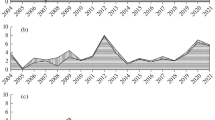Abstract
Distances and directions of Apodemus agrarius and Clethrionomus glareolus movements were studied using snap traps and colored bait. The longest distances traversed exceeded 1500 m. Some directions of movement were significantly more common. High variability in the number of captures along traplines suggests distinct movement routes. Small mammals appear to base their movement on the landscape and not on individual biotopes.
Similar content being viewed by others
References
Adler, G.H. 1987. Influence of habitat structure on demography of two rodent species in eastern Massachusets. Can. J. Zool. 65: 903–912.
Andrzejewski, R. and Babinska-Werka, J. 1986. Bank vole populations: are their densities really high and individual home ranges small? Acta theriol. 31: 407–420.
Bergstrom, B.J. 1988. Home ranges of three species of chipmunks (Tamias) as assessed by radiotelemetry and grid trapping. J. Mammal. 69: 190–193.
Brown, L.E. 1966. Home range and movement of small mammals. Symp. Zool. Soc. Lond. 18: 111–142.
Clark, B.K., Kaufman, D.W., Kaufman, G.A., Finck, E.J., Flinck, E.J. and Hand, S.S. 1989. Long-distance movements by Reithrodontomys megalotis in tallgrass prairie. Am. Midl. Nat. 120: 276–281.
Den Boer, P.J. 1981. On the survival of populations in a heterogenous and variable environment. Oecologia 50: 39–53.
Fahrig, L. and Merriam, G. 1985. Habitat patch connectivity and population survival. Ecology 66: 1762–1768.
Furrer, R.H. 1973. Homing of Peromyscus maniculatus in the channelled scablands of east-central Washington. J. Mammal. 54: 466–482.
Hansson, L. 1977. Spatial dynamics of field voles, Microtus agrestis in heterogenous landscapes. Oikos 29: 539–544.
Hansson, L. 1979. On the importance of landscape heterogeneity in northern regions for the breeding population densities of homeotherms: a general hypothesis. Oikos 33: 182–189.
Hansson, L. 1987. Dispersal routes of small mammals at an abandoned field in central Sweden. Holarctic Ecology 10: 154–159.
Henderson, M.T., Merriam, G. and Wegner, J. 1985. Patchy environments and species survival: chipmunks in an agricultural mosaic. Biol. Conserv. 31: 95–105.
Holisova, V. 1968. Marking small mammals by means of coloured admixtures to bait. Small Mamm. Newsl. 2: 36–40.
Innes, J.G. and Skipworth, J.P. 1983. Home ranges of ship rats in a small New Zealand forest as revealed by trapping and tracking. New Zealand J. Zool. 10: 99–110.
Jamon, M. and Bovet, P. 1987. Possible use of environmental gradients by homing wood mice Apodemus sylvaticus. Behav. Processes 15: 93–107.
Liro, A. and Szacki, J. 1987. Movements of field mice Apodemus agrarius (Pallas) in a suburban mosaic of habitats. Oecologia 74: 438–440.
MacArthu, R.H. and Wilson, E.O. 1967. The Theory of Island Biogeography. Princeton University Press, New York.
Merriam, G. 1988. Landscape dynamics in farmland. Trends in Ecol. & Evol. 3: 16–20.
Merriam, G. 1990. Ecological processes in the time and space of farmland mosaics. In Changing Landscapes: An Ecological Perspective, pp. 121–133. Edited by I.S. Zonneveld and R.T.T. Forman. Springer, New York.
Middleton, J. and Merriam, G. 1981. Woodland mice in a farmland mosaic. J. Appl. Ecol. 18: 703–710.
Middleton, J. and Merriam, G. 1983. Distribution of woodland species in farmland woods. J. Appl. Ecol. 20: 625–644.
Randolph, S.E. 1973. A tracking technique for comparing individual home ranges of small mammals. J. Zool. Lond. 170: 509–520.
Risser, P., Karr, J.R. and Forman, R.T.T. 1984. Landscape ecology. Directions and approaches. Illinois Natural History Survey Special Publ. 2: 1–18.
Robinson, W.L. and Falls, J.B. 1965. A study of homing of meadow mice. Am. Midl. Nat. 73: 188–224.
Sheppe, W. 1967. The effect of livetrapping on the movements of Peromyscus. Am. Midl. Nat. 78: 471–481.
Stickel, L.F. 1968. Home range and travels. In Biology of Peromyscus (Rodentia). Edited by J.A. King. pp. 373–411. Special Publ. No. 2 Am. Soc. of Mammal.
Tegelström, H. and Hansson, L. 1987. Evidence of long distance dispersal in the common shrew (Sorex araneus). Z. Säugetierk. 52: 52–54.
VanDruff, L.W. and Rowse, R.N. 1986. Habitat association of mammals in Syracuse, New York. Urban Ecol. 9: 413–434.
Author information
Authors and Affiliations
Rights and permissions
About this article
Cite this article
Szacki, J., Liro, A. Movements of small mammals in the heterogeneous landscape. Landscape Ecol 5, 219–224 (1991). https://doi.org/10.1007/BF00141436
Issue Date:
DOI: https://doi.org/10.1007/BF00141436




